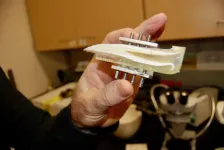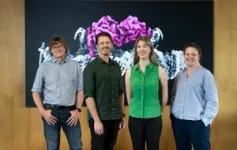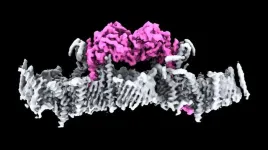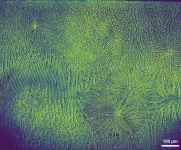(Press-News.org) Teeth recovered from a beloved zoo elephant that died in 2008 are helping University of Utah geologists develop a method for tracking the movements of large herbivores across landscapes, even for animals now extinct, such as mastodons and mammoths.
Outlined in recently published findings, the technique analyzes isotope ratios of the element strontium (Sr), which accumulates in tooth enamel. For large plant-eating land mammals, the relative abundance of two strontium isotopes in teeth and tusks reflects where the creature may have roamed during its lifetime.
“Our study not only adds to our understanding of how tooth enamel records an animal’s Sr isotope exposure, but also helps to reconstruct animal migrations from Sr isotope analysis,” lead author Deming Yang said in a posting about the research. “It can be applied to studies of paleobiology, to answer how megaherbivores migrated in the past. It can also be applied to studies of modern conservation and forensics, to trace the origins of illegal ivory trade and other forms of wildlife trafficking.”
The star of the study is Misha, a female elephant acquired by Salt Lake City’s Hogle Zoo in 2005.
Chemically similar to calcium, strontium from the environment accumulates in highly mineralized tissues, such as animals’ bones and teeth.
“As animals eat and drink, they pick up this environmental signature and store it in their teeth, preserving a series of environmental exposures like historic archives,” Yang wrote. This is because the geology of different places presents different isotope signatures for 87-strontium/86-strontium [87Sr/86Sr] and those isotope ratios are reflected in plants and water.
“We use other elements, but in this case, we’re focusing on strontium, which has proven to be really useful because of its strong link to geology,” coauthor Gabe Bowen said. “Ultimately it comes down to where that element comes from, how the animal gets it into their body and from what sources.”
The isotope 87Sr is radiogenic, meaning it is produced from the decay of another element, in this case rubidium, found next door to strontium on the Periodic Table, whose half-life exceeds 49 billion years, about 10 times the age of Earth. While 87Sr increases over time, the abundance of other strontium isotopes remains fixed. Accordingly, isotope ratios are a proxy for the age of rocks and typically differ from place to place.
Coauthor Thure Cerling, a highly decorated distinguished U professor of both geology and biology, is a pioneer in the use of isotope analysis to shed light on ecological questions such as soil formation, animal physiology, wildlife ecology and climate change.
Upon hearing of Misha’s death in news reports in 2008, Cerling saw a rare chance to advance the science of isotope geology. He reached out to Hogle Zoo to get permission to extract the elephant’s molars and a tusk before she could be buried. What made the teeth so useful to Cerling and his colleagues was the veterinary record of where Misha lived over the 27-year course of her life.
As a postdoctoral researcher, Yang led the research to investigate how Misha’s tusk and teeth recorded her strontium exposures years before her death, including her relocation history. The elephant arrived in Salt Lake City in 2005 from Six Flags Discovery Kingdom in Vallejo, California.
“It’s a very simple movement history. She lived in one location for a decade or more, and then moved here [to Salt Lake City], and we know the date of that move,” Bowen said. “We don’t have a lot of opportunities to see these kinds of natural experiments.”
The team used laser ablation to sample material from various growth lines along the elephant’s tooth enamel and tusk, which was measured using a mass spectrometer capable of identifying amounts of strontium isotopes they contained.
The researchers found that the innermost layer of enamel best preserves the isotope record and is the ideal place for sampling.
“We determined the strontium isotopes from the top to the bottom of the tooth in different parallel lines and those represent different times in the growth of Misha,” said geologist Diego Fernandez, who operates the U’s mass spectrometry lab. “It captured the time where Misha was moved from California to Utah.”
Undergraduate Katya Podkovyroff helped Fernandez refine the lab procedures for taking samples of bioapatite, the calcium material that makes up bone and enamel.
“It was in this lab where I got my first hands-on experience with scientific research, and I immediately fell in love. One of the most thrilling aspects of the job was learning that each sample carried a history, a mystery waiting to be unraveled through chemical signatures,” said Podkovyroff, now a graduate student at the University of Oregon.
“This research was both exciting and challenging: sampling ivory required extreme precision, as even minor contamination could alter results, and isotope purification is a meticulous and time-consuming process,” she continued. “The most rewarding aspect of this project was its broader implications beyond a single case study: it has applications in modern conservation efforts, with the ability to trace the origins of illegal ivory trade.”
The study titled, “Strontium isotope mapping of elephant enamel supports an integrated microsampling-modeling workflow to reconstruct herbivore migrations,” published Feb. 21 in the journal Communications Biology. Yang is now a postdoctoral researcher at the American Museum of Natural History, pursuing an interest in the ecology of extinct animals. Coauthors include paleoecologist Kevin Uno, who worked on Misha’s teeth as a graduate student at the U. Uno is now a professor of human evolutionary biology at Harvard University.
END
Misha lived in zoos, but the elephant’s tooth enamel helps reconstruct wildlife migrations
Utah geologists show how strontium isotopes found in teeth or tusks reveal where large plant-eating animals have roamed
2025-03-13
ELSE PRESS RELEASES FROM THIS DATE:
Eat better, breathe easier? Research points to link between diet, lung cancer
2025-03-13
For cancers of organs like the liver, the long-term impact of our diet has been well studied — so much so that we have guidance about red meat, wine and other delicacies.
A new study from researchers at University of Florida Health looks at another kind of organ whose cancer risk may be affected by poor diet: the lungs. The study was funded by several National Institutes of Health grants and a collaboration between the University of Kentucky's Markey Cancer Center and the UF Health Cancer Center.
“Lung ...
Mesozoic mammals had uniform dark fur
2025-03-13
The early mammals that lived alongside the dinosaurs upwards of 150 million years ago (mya) were likely covered in dark and dusky greyish-brown fur, according to a quantitative reconstruction of Mesozoic mammal coloration, hinting at their shrouded and nocturnal nature. The findings, drawn from a comparative analysis of fossilized melanosomes, provide insights into the ecology and evolutionary history of early mammals. From communication to camouflage, animal coloration plays an important role in numerous behavioral ecological ...
Wartime destruction of Kakhovka Dam in Ukraine has long-term environmental consequences
2025-03-13
The deliberate destruction of the Kakhovka Dam in Ukraine during the Russo-Ukrainian war unleashed a hidden environmental crisis, destroying ecosystems and releasing polluted sediments into downstream water systems, according to a new study. The findings provide critical new insights into the prolonged ecological risks of strategic dam destruction during warfare and the effects that may persist for years beyond war. “Our work highlights the far-reaching environmental consequences of the [Kakhovka Dam] destruction and raises concerns not only about the use of water as a weapon, but also about ...
NIH’s flat 15% funding policy is misguided and damaging
2025-03-13
The U.S. National Institutes of Health’s recent decision to impose a 15% cap on facilities and administrative (F&A) cost reimbursements threatens to undermine the quality and sustainability of university research by slashing indirect funding by $4 billion. In a Policy Forum, Jeongwon Choi and colleagues argue that this policy is fundamentally flawed, as it disregards the essential role of indirect costs, such as infrastructure, utilities, and administrative support, in enabling scientific research. The current system, governed by rigorous federal oversight and audits, ensures that F&A reimbursements are fair and necessary, varying across institutions based on actual costs. NIH’s ...
AI reveals new insights into the flow of Antarctic ice
2025-03-13
As the planet warms, Antarctica’s ice sheet is melting and contributing to sea-level rise around the globe. Antarctica holds enough frozen water to raise global sea levels by 190 feet, so precisely predicting how it will move and melt now and in the future is vital for protecting coastal areas. But most climate models struggle to accurately simulate the movement of Antarctic ice due to sparse data and the complexity of interactions between the ocean, atmosphere, and frozen surface.
In a paper published March 13 in Science, researchers at Stanford University used machine learning to analyze high-resolution ...
Scientists solve decades-long Parkinson’s mystery
2025-03-13
WEHI researchers have made a huge leap forward in the fight against Parkinson’s disease, solving a decades-long mystery that paves the way for development of new drugs to treat the condition.
First discovered over 20 years ago, PINK1 is a protein directly linked to Parkinson’s disease – the fastest growing neurodegenerative condition in the world. Until now, no one had seen what human PINK1 looks like, how PINK1 attaches to the surface of damaged mitochondria, or how it is switched on.
In ...
Spinning, twisted light could power next-generation electronics
2025-03-13
Researchers have advanced a decades-old challenge in the field of organic semiconductors, opening new possibilities for the future of electronics.
The researchers, led by the University of Cambridge and the Eindhoven University of Technology, have created an organic semiconductor that forces electrons to move in a spiral pattern, which could improve the efficiency of OLED displays in television and smartphone screens, or power next-generation computing technologies such as spintronics and quantum computing.
The semiconductor they developed emits circularly polarised ...
A planetary boundary for geological resources: Limits of regional water availability
2025-03-13
Geological resources such as critical metals and minerals, essential for the diffusion of technologies such as renewable energy and energy storage towards a decarbonized society, are indispensable for supporting modern life in the form of various products and services. Their demand is expected to increase in the coming years owing to global population as well as economic growth. Thus far, scientists and policymakers have primarily discussed geological resource availability from the viewpoint of reserves and resources in the ecosphere and technosphere. However, resources such as ...
Astronomy’s dirty window to space
2025-03-13
When we observe distant celestial objects, there is a possible catch: Is that star I am observing really as reddish as it appears? Or does the star merely look reddish, since its light has had to travel through a cloud of cosmic dust to reach our telescope? For accurate observations, astronomers need to know the amount of dust between them and their distant targets. Not only does dust make objects appear reddish (“reddening”), it also makes them appear fainter than they really are (“extinction”). It’s like we are looking out into space through a dirty ...
New study reveals young, active patients who have total knee replacements are unlikely to need revision surgery in their lifetime
2025-03-13
A 40-year study by Hospital for Special Surgery (HSS) researchers has found that active young adults who underwent total knee replacement were unlikely to require knee replacement revision in their lifetime, according to a new study shared today in a podium presentation at the American Academy of Orthopaedic Surgeons 2025 Annual Meeting.1
“As an increasing number of younger adults in their 40s and 50s consider total knee replacement, many wonder how long knee implants last before requiring a revision procedure,” ...
LAST 30 PRESS RELEASES:
House sparrows in northern Norway can help us save other endangered animals
Crohn's & Colitis Foundation survey reveals more than 1/3 of young adults with IBD face step therapy insurance barriers
Tethered UAV autonomous knotting on environmental structures for transport
Decentralized social media platforms unlock authentic consumer feedback
American Pediatric Society announces Vanderbilt University School of Medicine as host institution for APS Howland Visiting Professor Program
Scientists discover first method to safely back up quantum information
A role for orange pigments in birds and human redheads
Pathways to net-zero greenhouse gas emissions for Southeast Asia
A JBNU–KIMS collaborative study on a cost-effective alloy matches superalloys for power plants and energy infrastructure
New study overturns long-held model of how plants coordinate immune responses.
New AI model predicts disease risk while you sleep
Scientists discover molecular ‘reshuffle’ and crack an 80-year-old conundrum
How stressors during pregnancy impact the developing fetal brain
Electrons lag behind the nucleus
From fungi to brain cells: one scientist's winding path reveals how epigenomics shapes neural destiny
Schizophrenia and osteoporosis share 195 genetic loci, highlighting unexpected biological bridges between brain and bone
Schizophrenia-linked genetic variant renders key brain receptor completely unresponsive to both natural and therapeutic compounds
Innovative review reveals overlooked complexity in cellular energy sensor's dual roles in Alzheimer's disease
Autism research reframed: Why heterogeneity is the data, not the noise
Brazil's genetic treasure trove: supercentenarians reveal secrets of extreme human longevity
The (metabolic) cost of life
CFRI special issue call for papers: New Frontiers in Sustainable Finance
HKU Engineering scholar demonstrates the smallest all-printed infrared photodetectors to date
Precision empowerment for brain "eavesdropping": CAS team develops triple-electrode integrated functional electrode for simultaneous monitoring of neural signals and chemical transmitters during sleep
Single-capillary endothelial dysfunction resolved by optoacoustic mesoscopy
HKU three research projects named among ‘Top 10 Innovation & Technology News in Hong Kong 2025’ showcasing excellence in research and technology transfer
NLRSeek: A reannotation-based pipeline for mining missing NLR genes in sequenced genomes
A strand and whole genome duplication–aware collinear gene identification tool
Light storage in light cages: A revolutionary approach to on-chip quantum memories
Point spread function decoupling in computational fluorescence microscopy
[Press-News.org] Misha lived in zoos, but the elephant’s tooth enamel helps reconstruct wildlife migrationsUtah geologists show how strontium isotopes found in teeth or tusks reveal where large plant-eating animals have roamed






